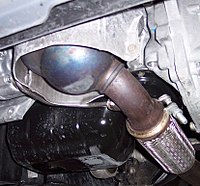
Photo from wikipedia
Contamination flashover of insulators is one of the main threats to the safety of power systems, and regular cleaning of insulator surface pollution is an effective solution to this problem.… Click to show full abstract
Contamination flashover of insulators is one of the main threats to the safety of power systems, and regular cleaning of insulator surface pollution is an effective solution to this problem. In this paper, the laser cleaning of ceramic insulators is studied via simulations and experiments. The adhesion between a contamination layer and an insulator surface is estimated. A laser cleaning model for contaminated insulators is established, and a numerical analysis of the thermal stress field distribution characteristics of laser cleaning is carried out. Various factors that affect the thermal stress field distribution, including the laser power, laser scanning speed and thickness of the contamination layer, are also analysed. The optimal cleaning parameters for the best performance of laser cleaning are obtained through simulation and experiments. The result shows if the equivalent salt deposit density (ESDD) is 0.05 mg/cm2, and the nonsoluble deposit density (NSDD) is 0.25 mg/cm2, the best cleaning effect could be achieved when the laser power is 100 W and the scanning speed reached 6000 mm/s.
Journal Title: IEEE Access
Year Published: 2022
Link to full text (if available)
Share on Social Media: Sign Up to like & get
recommendations!